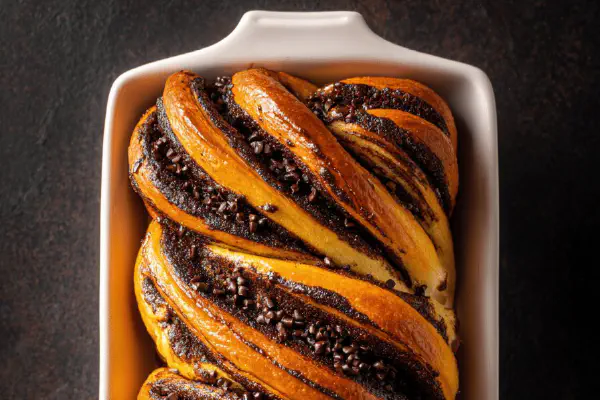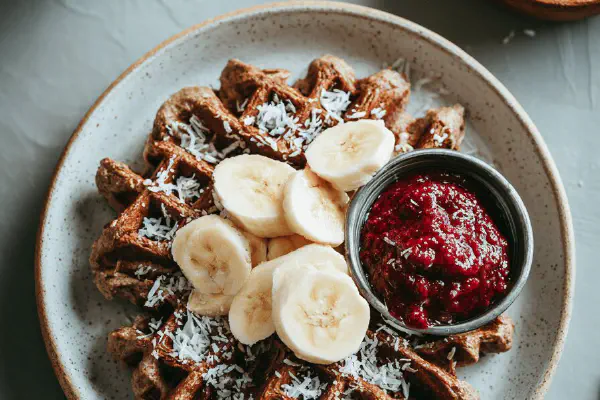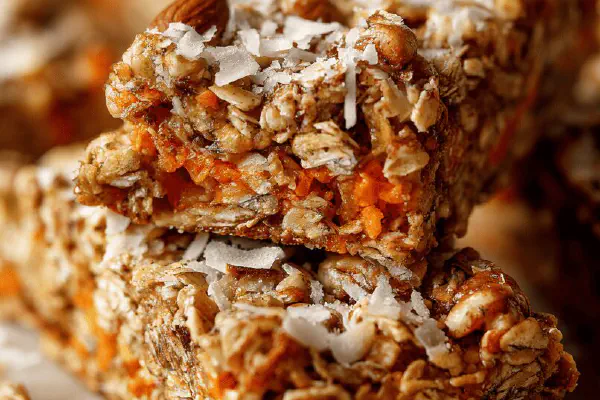Belgian Waffles Redo

By Emma
Certified Culinary Professional
Ingredients
- 240 ml cream, room temperature
- 60 ml (1/4 cup) vegetable oil
- 200 g (1 1/3 cups) all purpose flour
- 12 ml (2 1/2 tsp) sugar
- 3 ml (3/4 tsp) rapid yeast
- 3 ml (3/4 tsp) fine sea salt
- 1 large egg
- 45 g (3 tbsp) coarse sugar crystals
About the ingredients
Method
Mix liquids first: Cream and oil into a bowl. No rushing, room temp keeps fats happy in dough.
Dry mix: Flour, sugar, yeast, salt in another bowl. Notice how you smell the yeast? Not like sour yet good. Toss egg in, whisk. Clumps will linger.
Combine: Slowly stream liquid in, whisk gently—leave lumps—don’t sweat it. Overmixing kills texture. Cover, fridge 8-14 hours is gold; longer is no issue but no less than 8.
Heat waffle iron: Medium-high. Toss a pinch of coarse crystals in each cavity; they caramelize. Ladle roughly 75 ml batter in. Don’t overfill or it ends up soggy.
Cook: Close, steam hisses should ease in 4-6 minutes. Peek edges—deep amber, crisp not burnt. Remove carefully with tongs. Keep warm tented in a tea towel on a rack.
Repeat: Each batch may cook quicker as iron stays hot. If smoke, lower heat slightly. Extra batter? Freeze spoonfuls on parchment.
Serving hint: Play with coarse sugar topping - swap for chopped crystallized ginger or cinnamon-sugar blend for a twist.
Storage: Leftovers? Reheat in toaster oven or sauté pan. Avoid microwave; they turn limp fast.
Cooking tips
Chef's notes
- 💡 Mix fats cold but at room temperature; hot kills yeast fast. First cream then oil—stirs better than butter swaps. Liquid fat mix keeps batter silky not greasy. Using cold but not fridge temps helps yeast wake nice. Watch lumps—don’t smooth out; gluten wants to chill rough. Over mixing kills texture here. Cover batter tight or fridge smells go in. Eight to fourteen hours in fridge best; less no flavor, longer risk sour.
- 💡 When dry mixing, add yeast and salt apart. Salt kills yeast if contact direct. Egg joins dry first. Then liquids stream slowly—don’t whisk hard. Underdeveloped gluten sticks around as lumps, texture’s secret. No rushing here or batter flattens. Fridge at 4°C best, not warmer. Timing loose, 8 minimum. Watch batter thickness; runny means liquid overload or cold fats not melted. If too thick, add tiny splash cream, not milk.
- 💡 Heat waffle iron medium-high; too hot burns edges, too low soggy waffles. Sprinkle coarse sugar crystals each cavity before batter; they caramelize with that sizzling crackle sound—sign of heat right. Ladle about 75 ml batter; overfill soggy, underfill thin waffles. Watch steam; when stops hissing and edges go deep amber, pull. This is doneness clue. Peek edges crisp but not black. Keep waffles warm tented in tea towel to dry but not steam up. Avoid plastic wrap on waffles.
- 💡 Use coarse sugar crystals for signature crunch; substitutes are pearl sugar chopped or crushed nib sugar if crystals unavailable. Pearls dissolve fast, coarse hold longer and crackle. If no crystals, try cinnamon-sugar blend sprinkled on top after cooking for alternative crunch. Freeze leftover batter in spoonfuls on parchment; no rising needed in freezer. Thaw in fridge overnight before cooking. Reheat waffles in toaster oven or skillet for crispness back. Microwave makes limp soggy mess.
- 💡 Watch batter texture not just timing. Lumps persist, runny bad. Cream over milk thickens batter, holds moisture longer. Oil replaces butter, melts evenly and prevents cold lumps. Flour slightly less—makes batter delicate, less gluten snap which helps keep waffles tender inside. Yeast bumped for steady rise, but don’t over ferment or sour. Cover batter tight; fridge odors reach in. Longer than 18 hours fridge risks sour and flat batter. Timing matters more than temperature guesses.
Common questions
How long to rise batter?
Minimum eight hours fridge. Less means weak yeast, flavor dull. Fourteen hours good window. Over eighteen risks sour taste. Fridge temp steady at 4°C. Room temp rise kills texture and can rush yeast.
Can I swap cream for milk?
Cream thickens batter better, holds moisture. Milk thins, may cause runny batter lumpy issue. Oil not butter better cold fats for yeast. If milk only, reduce liquid slightly or expect thinner batter and less tender crumb.
Why are waffles soggy sometimes?
Too much batter in iron or heat too low. Steam needs to stop hissing before removing. Overmixing kills crumb structure making dense batter that holds moisture. Sugar crystals help dry surface with caramelization. Avoid wrapping waffles hot in plastic, towel tent only.
How to store leftovers?
Freeze cooked waffles best in airtight bag. Reheat in toaster oven or skillet to revive crunch. Batter freezes spooned, no rise after thaw just cook. Fridge leftovers dry waffles fast. Avoid microwave unless emergency; makes them limp and rubbery.



